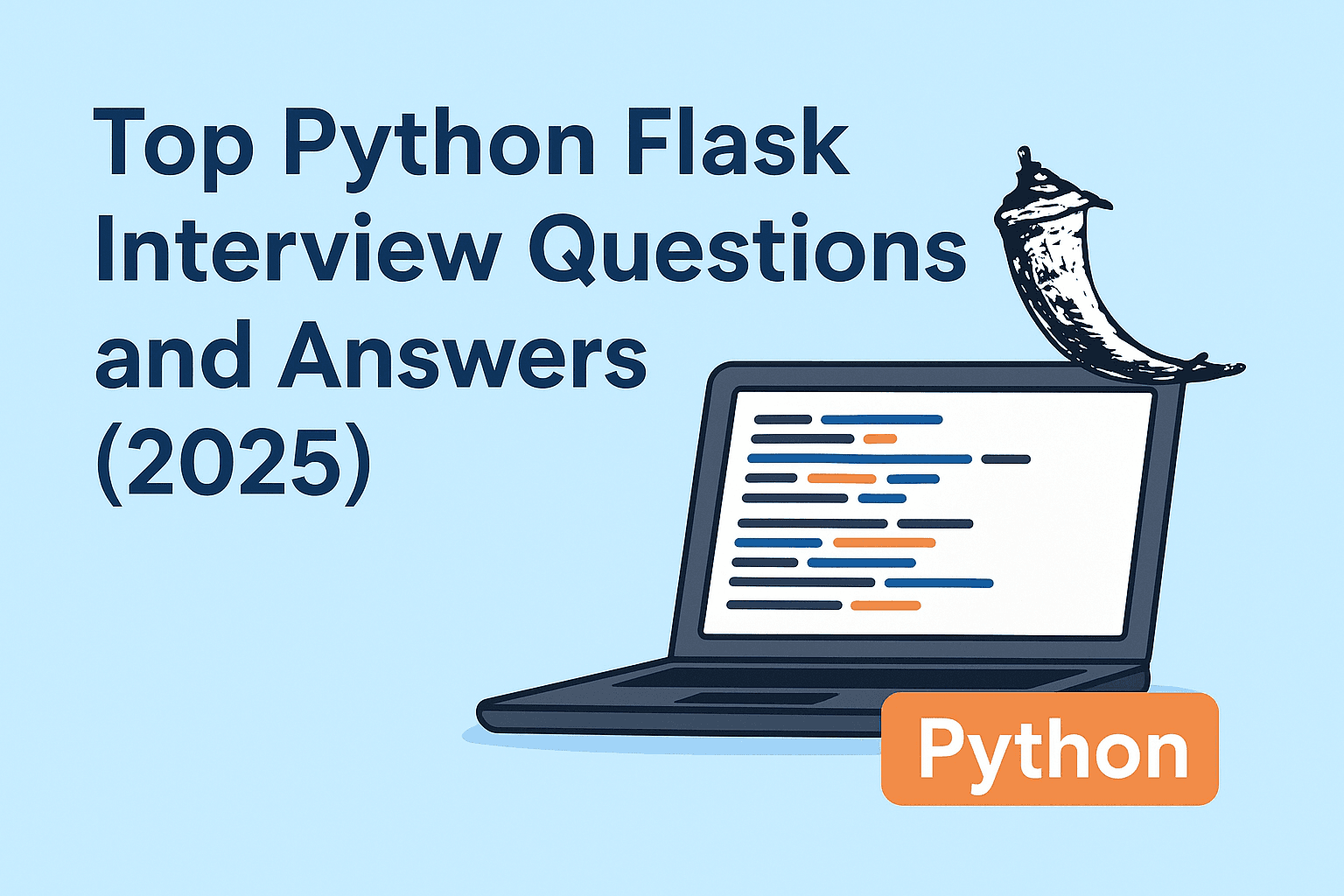Flask is a lightweight and flexible Python web framework widely used for building web applications and RESTful APIs. Its simplicity, modularity, and ease of integration with other libraries make it a popular choice for developers. If you’re preparing for a Python Flask interview, understanding both fundamental concepts and practical applications is key.
This guide provides a comprehensive list of Python Flask interview questions and answers to help you succeed, whether you’re a beginner or an experienced developer.
Basic Questions
-
-
What is Flask?
Flask is a micro web framework written in Python, which allows you to build web applications quickly and with minimal setup. -
What is a Flask route?
A route maps a URL to a Python function. For example:
-
-
-
How do you run a Flask application?
-
-
-
What is the difference between Flask and Django?
Flask is lightweight and flexible with fewer built-in features, while Django is a full-featured framework with ORM, authentication, and admin panel. -
What are Flask templates?
Flask uses Jinja2 templates to dynamically generate HTML pages. -
What is the role of
Flaskobject?
It acts as the core application object and is used to configure routes, error handlers, and extensions. -
How do you pass data from Flask to templates?
Using therender_templatefunction:
-
-
-
What is
Flask-SQLAlchemy?
It’s an extension that simplifies database operations using SQLAlchemy ORM. -
How do you handle form data in Flask?
Usingrequest.formfor POST requests:
-
-
-
What is a Flask Blueprint?
Blueprints allow you to organize Flask applications into modular components.
-
Intermediate Questions
-
-
Explain Flask request lifecycle.
It starts with the HTTP request, routing, middleware processing, view function execution, template rendering, and finally sending a response. -
How do you manage sessions in Flask?
Flask uses signed cookies to store session data via thesessionobject:
-
-
-
What are Flask decorators?
Decorators are used to modify the behavior of a function or route, e.g.,@app.route('/'). -
Explain URL converters in Flask.
They define the type of variable in a route:
-
-
-
How do you handle errors in Flask?
Using error handlers:
-
-
-
What is Flask-WTF?
It’s an extension for handling forms, validation, and CSRF protection. -
How can you serve static files in Flask?
Place them in thestaticfolder and access via/static/<filename>. -
Explain Flask configuration methods.
Configurations can be set usingapp.config['KEY'], environment variables, or separate config files. -
How do you redirect in Flask?
-
-
-
What is
Flask-Migrate?
An extension for handling database migrations using Alembic.
-
Advanced Questions
-
Explain middleware in Flask.
Middleware is a function that runs before or after a request to process it, often used for logging or authentication. -
How do you implement authentication in Flask?
Using Flask-Login or JWT tokens for session management and protected routes. - Explain context in Flask (Application and Request context).
-
-
Application context holds
current_appandgobjects. -
Request context holds
requestandsessionobjects.
-
-
How to handle file uploads in Flask?
Usingrequest.filesand saving files securely:
-
Explain how to create RESTful APIs in Flask.
Use Flask routes with HTTP methods (GET, POST, PUT, DELETE), optionally with Flask-RESTful extension. -
What is Flask’s
gobject?
A global namespace for storing data during a request lifecycle. -
Explain signal handling in Flask.
Flask signals (via Blinker) allow decoupled components to respond to events like template rendering. -
How to implement caching in Flask?
Using Flask-Caching or third-party caching solutions like Redis. -
How can you secure a Flask application?
Use HTTPS, secure cookies, CSRF protection, input validation, and proper error handling. -
Explain async support in Flask 2.x.
Flask now supports asynchronous view functions usingasync def, improving performance for I/O-bound tasks.
Scenario-Based Questions
-
You need to create a multi-page website with reusable components. How would you structure it?
Use Blueprints to modularize the app, templates with inheritance, and static folders for assets. - Handling high traffic API with Flask
-
-
Use Gunicorn or uWSGI as WSGI servers
-
Enable caching for frequent responses
-
Use a database connection pool
-
- Migrating a Flask app to production
-
-
Use environment-specific config
-
Enable logging
-
Configure HTTPS and reverse proxy with Nginx or Apache
-
Conclusion
Preparing for Python Flask interviews requires a mix of theory and hands-on practice. Focus on routing, templates, database interactions, and real-world application design. Practicing scenario-based questions will give you confidence for practical problems.

